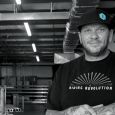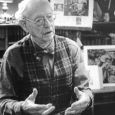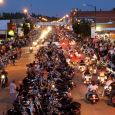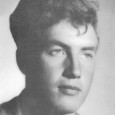The Gift of South Dakota
Subscriptions to South Dakota Magazine make great gifts!
Subscribe today — 1 year (6 issues) is just $29!
Spinoffs from Sturgis
The rumble of motorcyclists attracted by the Sturgis Rally fades with the pages of the calendar. But listen carefully and you may hear another motorcycling sound across South Dakota: the year-around hum of manufacturing, engineering research, and bike adaptations.
No one says the motorcycle industry is recession proof. A motorcycle is a luxury purchase for most buyers, but good bikes generally hold their value over time and are smart investments. Also there are high-end bike collectors, both in the United States and abroad, for whom the current recession is mostly rumor, and whose latest two-wheel purchase exceeded what most of us spent for our homes. Some South Dakota manufacturers have grown about as fast as companies could ever hope in recent years, and if sales slowed during the economic downturn of 2008 and 2009, it felt like a mere bump in the track.
Company leaders say there’s an advantage in basing a motorcycle company in South Dakota. It’s a place bikers warmly associate with spectacular rides, freedom, annual reunions, and residents who are anything but buttoned-down. Plenty of industry leaders are transplants that seem to understand South Dakota’s mystique better than its natives do. Something else — base your company in South Dakota and lots of customers will stop every August for face-to-face hellos and consultations.
So get your motor running, head out on the highway, and meet some people who make biking a 12-month enterprise in South Dakota.
 |
| Brian Klock spent 15 years building a Mitchell bike business called Klock Werks. His bikes began to set records at Bonneville after he designed a new windshield during a Discovery Channel Build-Off contest. |
Mitchell
How do you set a world’s speed record on Utah’s Bonneville salt flats? You need the right engine, the right rider, and as Brian Klock learned to his great benefit, you need the right windshield.
Over the past 17 years, Klock built up Klock Werks, a company that earned a great reputation producing parts for customizing bikes. Fenders, handlebars, gauges, exhaust systems — about 350 parts in all — are shipped everywhere, mostly with pre-drilled holes so buyers can build or rebuild their bikes themselves. Klock Werks won a loyal customer base, especially among Harley-Davidson owners who ride baggers. Baggers are long distance bikes with compartments, or bags, for stowing travel gear. Klock Werks products told the biker world that baggers could be stylish.
But could a bagger go fast?
 |
| Brian and Laura Klock |
When the Discovery Channel invited Klock to participate in a biker build-off a few years ago, he decided to create the WFB (Way Fast Bagger). Part of his design was a new windshield. The standard issue windshield on this Harley bike, he discovered, moved air so that the bike’s front end actually rose a bit at high speeds. The lift slowed the bike and resulted in less stability and even a wobble. Klock’s new windshield, now sold as the Flare, directed the wind downward — a plus for rider comfort, safety, and speed. Klock won the build-off and took the bike to Bonneville in 2006.
He recruited a highly trusted rider, Laura Ellifson, for the salt flats time trials. A year later she and Klock were married.
Laura hit 147 miles per hour, a record for her type of machine, in land speed racing at Bonneville in 2006. The WFB name stuck, only now the initials stood for World’s Fastest Bagger. Laura broke her own record at Bonneville in 2007 and again in 2008 when she was clocked at 153.593 mph. She believes that unofficially she has reached 160 mph.
What’s it like to fly like that across the salt on two wheels?
“You learn to challenge yourself and your machine, and you learn to handle your fears,” Laura says. “You look straight ahead, pick a spot and keep focused on it, and you don’t look down at the track because that can be intimidating. In this kind of racing you hold your speed over the course of a measured mile, so it’s different than drag racing where you hit your speed and then back off.”
She attracted lots of admirers, some of whom have her posters tacked to their garage walls, and she’s in demand as a speaker. But Laura is not the hard-driven competitor some of her fans might guess. What she loves about salt flats racing is the comradery and the chance to showcase Klock Werks innovations (however, Laura does take great pride in the fact that she and her bike racing teenage daughters, Erika and Karlee, were the first mother and daughters trio to simultaneously hold records at Bonneville).
 |
| Brian and Laura Klock first met at Bonneville, where Laura's daughters Erika and Karlee also hold records. |
Showcasing the Flare windshield’s attributes at Bonneville was a big step for Klock Werks. The windshield was perfected at the A2 Wind Tunnel in North Carolina and is now the company’s best selling product. It deserves much of the credit for the way Klock Werks grew in recent years from five employees to 20.
“It costs under $200, takes just a few minutes to install, and it really improves a ride,” says Makel Juarez on the sales floor in Mitchell.
Sturgis
If you own a pre-1930 Harley Davidson, there are two things you should know. First your source for parts is Competition Distributing of Sturgis, because no one else in the world builds such an extensive line of Harley components for 1905 through 1929 models. There are 1,620 parts available, most for Harleys, and some for other vintage bikes as well.
Second you should know there are more people like you than you might guess. Competition Distributing has a customer base of 14,000. Seventy-five percent of those buyers are European. Some days 150 parts shipments leave the shop on Lazelle Street in Sturgis. That’s where “seven workers do the work of 14,” says Lonnie Isam, company owner.
Isam notes a key difference between motorcycle collectors and people who collect cars. “Motorcyclists love their engines, just the opposite of lots of car collectors who tend to love the car’s body,” he says. “So with these bikes we start out with lots of motors and not so many chassis.”
If there’s a look that distinguishes pioneer bikes, it’s the box-shaped flat gas tanks. The very first, not surprisingly, resembled bicycles with motors attached, because that’s exactly what they were. But the machines soon acquired identities completely separate from bicycles.
“The engineering is so obvious on these early bikes, and I’ve learned to respect the way the engineering evolved quickly, especially from 1905 to 1920,” Isam says. “We rebuild complete bikes here a few times each year, and we go through the exact process that the first bike builders did.”
He never forgets the historical significance of his work. “These motorcycles,” he says, “are our thoroughbreds, our roots.”
 |
Isam grew up riding motorcycles in and around Seattle, then owned a Harley-Davidson dealership in Houston. In the 1970s, he says, “Harley-Davidson wasn’t cool, was having some labor problems, and you could pick up a dealership for just about nothing.” Isam and his wife, Marianne, ran the Houston shop for 34 years and at the same time were buying up struggling tool and dye companies there. “So I had equipment to make bike parts,” Isam recalls. If he made one part, he discovered, it made sense to make additional pieces as well. Sooner or later someone would need them.
Like so many others in the bike industry, Isam came to know the Black Hills through the rally and eventually bought property there. After the Isams sold their Houston dealership in 1999, they began thinking of a life in South Dakota. It was the right move. “In Sturgis,” Isam says, “I’ve forgotten what stress is.” He’s a new South Dakotan loyal to his adopted state—when he subcontracts work, he looks to Black Hills manufacturers and estimates that 80 percent of his company’s revenue remains in South Dakota.
It’s somehow appropriate that Carl Herman Lang’s 1905 Harley Davidson sits in this shop that’s dedicated to the integrity of vintage Harleys. Lang was an early Harley-Davidson investor, patent holder, and the very first dealer. It’s believed the company turned out five bikes in 1905—this one and only four others. If there’s a Rosetta Stone in the Harley world, this is it.
Spearfish
Ken Hines relocated from South Carolina to Spearfish to become president and CEO of Lehman Trikes, which bills itself as “leader of the three world.” A former Blue Angels pilot, Hines now enjoys more leisurely motorcycle rides.
“I only rode 900 miles this past weekend,” he laughs. “If you’re in the motorcycle industry and you find yourself in the northern Black Hills, what could be better?”
His company originated in Canada in 1985 and named Spearfish its United States assembly and distribution center in 2004. Initially there were four Spearfish employees, but seven years later more than 130 workers are spread throughout four buildings.
“We take a partially assembled two-wheel motorcycle, add a wider differential that will accept two rear wheels, and then we add those wheels,” explains Paul Pankonin, operations manager. “And the framework gets a new body and paint.”
 |
| Ken Hines moved to Spearfish to become President and CEO of Lehman Trikes, but soon fell in love with the Northern Hills and the great biking routes. Lehman Trikes were designed for safety in the 1980s. |
The Lehman story began in the early 1980s. Linda Lehman told her husband, John, that she wasn’t comfortable with their child riding on the back of a two-wheel bike. So for safety John created a three-wheel motorcycle. The customized machine won Linda’s appreciation and lots of attention wherever the family traveled. The Lehmans had struck gold and decided to mass-produce trikes, originally at Westlock, Alberta.
Today in Spearfish there are two assembly lines in a thoroughly modern, beautifully lit, and well-ventilated plant. Product demand keeps day and night shifts busy. One line culminates in a trike built for Harley-Davidson as a Harley product, and the other line turns out Lehman’s own products. About 130 dealers handle Lehman Trikes, across North America and Europe, and in Japan. Dealers who want Lehman kits for assembly in their own shops are invited to Spearfish for a four-day training session. Dealers are also invited to Spearfish for the rally each year, and can use the Lehman parking lot adjacent to Interstate 90 for demo rides and sales. “We open the factory for tours during rally week, too, but we never sell directly to the public,” Hines says. “Only through our dealers.”
It’s not only rally traffic and great Black Hills rides that have Hines singing South Dakota’s praises. “We love our workforce here,” he says, “and this is a state where the governor will come and visit for half an hour, and he knows your name and all about your business.”
Editor’s Note: This story is revised from the November/December 2009 issue of South Dakota Magazine. To order a copy or to subscribe, call 800-456-5117.











Comments